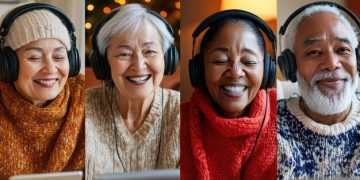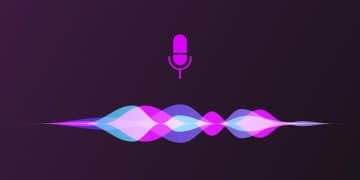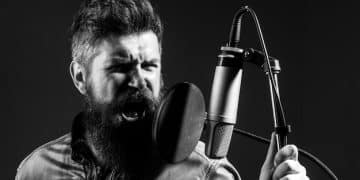Podcast Accessibility: Best Practices for Inclusive Listening

Podcast accessibility ensures individuals with disabilities can fully enjoy and engage with your content through transcripts, captions, and properly structured audio, thus expanding your audience and fostering inclusivity.
Creating inclusive podcasts ensures everyone, regardless of ability, can enjoy your content. By following podcast accessibility best practices: how to make your content inclusive for listeners with disabilities, you’re not just expanding your reach; you’re fostering a more equitable listening experience.
Why Podcast Accessibility Matters
Accessibility in podcasting is about removing barriers. It allows individuals with disabilities to access and enjoy audio content fully.
By prioritizing accessibility, you increase your podcast’s reach and demonstrate a commitment to inclusion.
Expanding Your Audience
Making your podcast accessible opens it up to a significantly larger audience. Many people with disabilities rely on features like transcripts and captions.
By providing these options, you ensure they can engage with your content just as easily as anyone else.
- Increased listenership through wider accessibility
- Improved engagement from a more diverse audience
- Enhanced reputation for inclusive content creation
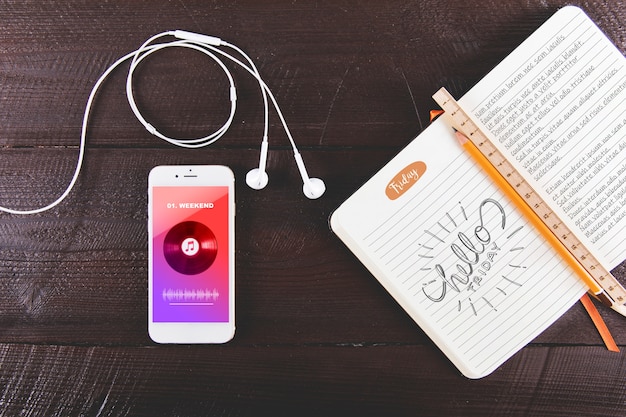
Demonstrating Social Responsibility
Going beyond legal compliance, accessibility showcases your brand’s values and commitment to social responsibility.
It demonstrates you care about inclusivity and equality, fostering a positive image.
Making your podcast accessible builds trust with your audience, fostering loyalty and advocacy for your content.
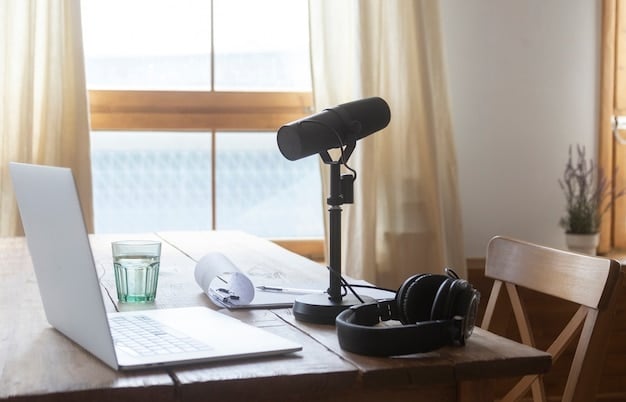
Practical Steps to Improve Accessibility
Implementing accessibility doesn’t have to be complex. Several practical steps can make your podcast much more inclusive.
From providing transcripts to optimizing audio, each step ensures a better listening experience for everyone.
Providing Transcripts
Transcripts are essential for accessibility. They provide a text version of your podcast’s audio content.
Transcripts enable listeners who are deaf or hard of hearing to follow along with your podcast.
- Accuracy is key to providing a transcription.
- Use timestamps to synchronize the transcript with the audio.
- Make transcripts easily accessible on your podcast’s website.
Adding Captions to Video Podcasts
For video podcasts, captions provide a visual representation of the audio content.
Captions are essential for audiences who are deaf or hard of hearing to have a seamless watching experience.
Captions can be created manually to ensure its accuracy or rely on automated services.
Optimizing Audio Quality
Clear audio is crucial for everyone, but especially for those with hearing impairments.
Optimize your audio to minimize background noise and ensure clear speech.
- Use high-quality microphones and recording equipment.
- Edit audio to reduce noise and improve clarity.
- Ensure consistent volume levels throughout the podcast.
Making Your Podcast Website Accessible
A podcast is not complete without an accessible website. Navigation and presentation can greatly affect usability.
A well-designed website ensures that all listeners can easily find and access your content.
Ensuring Easy Navigation
Make sure your website is easy to navigate, with clear and logical menus.
Use descriptive link text and provide alternative text for images.
Simplified navigation allows all users to easily explore available content.
Using Clear and Readable Fonts
Choose fonts that are easy to read and of a sufficient size. Avoid overly decorative fonts.
Ensure good color contrast between text and background.
A well readable font leads to longer listening sessions.
Accessibility Plugins
Use plugins and tools that can automatically check and improve your website’s accessibility.
These tools can identify issues like missing alternative text or poor color contrast.
Accessibility plugins help maintain an inclusive online presence.
Promoting Your Accessible Podcast
Once your podcast is accessible, let people know about it. Promoting your efforts can attract more listeners.
Effective promotion highlights the inclusive features of your podcast to a wider audience.
Highlighting Accessibility Features
Clearly communicate the accessibility features you offer, such as transcripts and captions.
Mention these features in your podcast descriptions and promotional materials.
Highlighting accessibility ensures potential listeners are aware of inclusive listening options.
Engaging with the Disability Community
Actively engage with disability advocacy groups and organizations.
Seek feedback and suggestions to continually improve your podcast’s accessibility.
Connect in disability communities to ensure you’re meeting real audience needs.
Leveraging Social Media
Use social media to showcase your commitment to accessibility.
Share transcripts, highlight captioned clips, and use relevant hashtags.
Social media amplifies the message of inclusion, reaching more listeners.
Tools and Technologies for Podcast Accessibility
Several tools and technologies can help you create and maintain an accessible podcast.
From transcription services to audio editing software, these tools streamline the production process.
Transcription Services
Use professional transcription services to ensure accurate and timely transcripts.
Many services offer specialized options like timestamps and speaker identification.
Quality transcription services improve the overall experience for listeners.
Audio Editing Software
Invest in audio editing software to optimize the quality of your podcast.
Remove background noise, adjust levels, and enhance clarity.
Audio editing software enables the creation of a smooth and enjoyable listening experience.
Captioning Tools
Use captioning tools to add captions to your video podcasts.
These tools allow you to synchronize captions with the audio content.
Useful captioning tools improve accessibility for viewers with hearing impairments.
Staying Updated on Accessibility Standards
Accessibility standards and guidelines evolve over time. Staying updated is essential.
Continuous learning ensures your podcast aligns with the latest best practices.
Following WCAG Guidelines
Familiarize yourself with the Web Content Accessibility Guidelines (WCAG).
These guidelines provide a framework for making web content more accessible.
Following WCAG guides informs the maintenance of optimal accessibility.
Monitoring Legal Updates
Keep an eye on legal updates related to accessibility.
Compliance with laws like the Americans with Disabilities Act (ADA) is crucial.
Legal monitoring ensures your podcast remains compliant with applicable laws.
Attending Accessibility Workshops
Participate in accessibility workshops and webinars.
Learn from experts and network with other content creators.
Workshop attendance leads to a deeper understanding of accessibility principles.
| Key Point | Brief Description |
|---|---|
| 📝 Transcripts | Text version of audio content for inclusivity. |
| 🔊 Audio Quality | Clear sound minimizes background noise. |
| 🌐 Website Navigation | Easy-to-use site for all listeners. |
| 📣 Promotion | Highlight accessible features to reach a broader audience. |
FAQ
▼
Podcast accessibility refers to making podcasts usable by people with disabilities. It includes providing transcripts, captions, and ensuring good audio quality, which increases inclusivity and audience reach.
▼
Podcast accessibility is important because it ensures that everyone, including those with disabilities, can enjoy and engage with your content. It expands your audience and demonstrates your commitment to inclusivity.
▼
You can make your podcast more accessible by providing transcripts for each episode, adding captions to any video content, optimizing the audio quality, and ensuring your podcast website is easy to navigate and use for everyone.
▼
Tools that can help with podcast accessibility include transcription services like Otter.ai, audio editing software such as Audacity, and captioning tools like Descript for video content that is published.
▼
To promote your accessible podcast, highlight the accessibility features you offer in your podcast descriptions, engage with disability advocacy groups, and share transcripts and captioned clips on social media. This helps spread the word among prospective inclusive listers.
Conclusion
Implementing podcast accessibility best practices: how to make your content inclusive for listeners with disabilities not only broadens your audience but also enriches the listening experience for everyone. By providing transcripts, optimizing audio quality, and maintaining an accessible website, you demonstrate a commitment to inclusion and social responsibility. Stay updated on accessibility standards and continue to engage with the disability community to ensure your podcast remains accessible and enjoyable for all.
